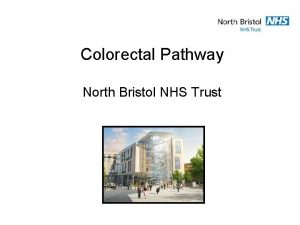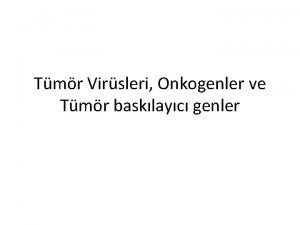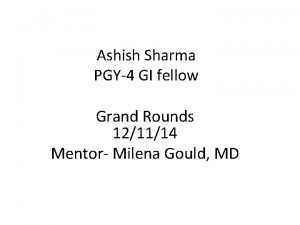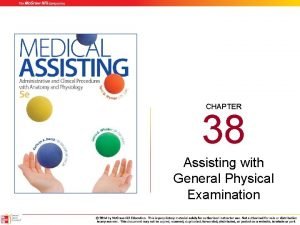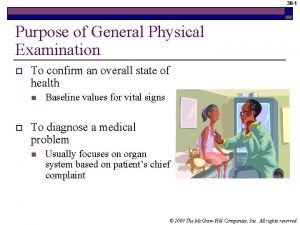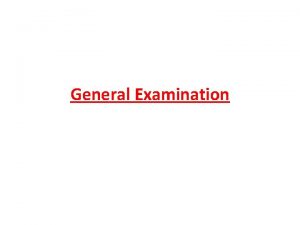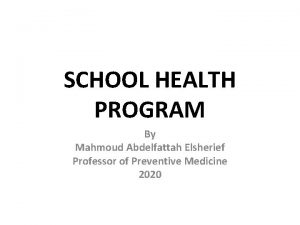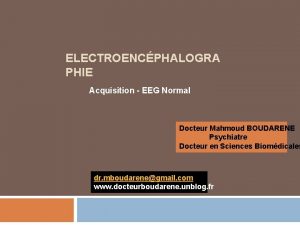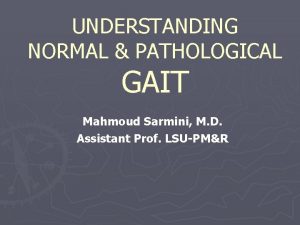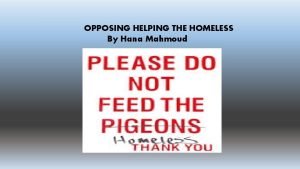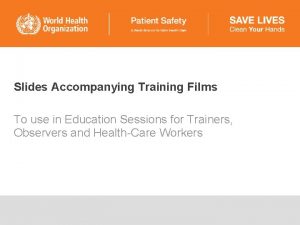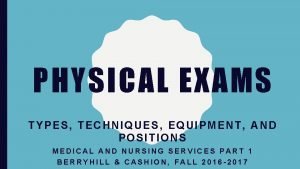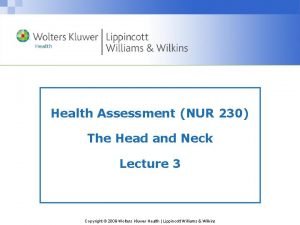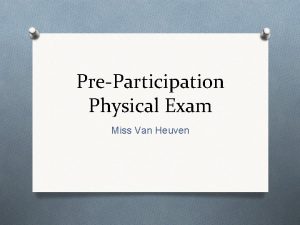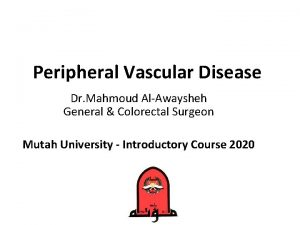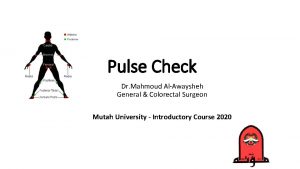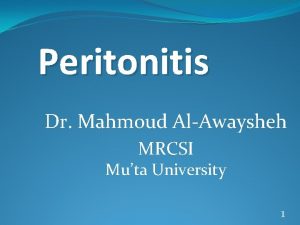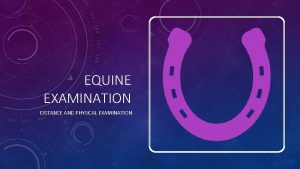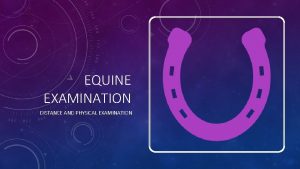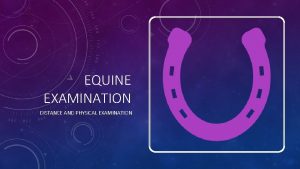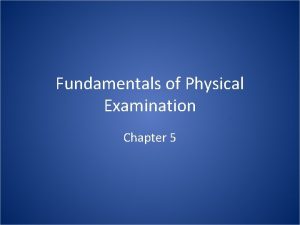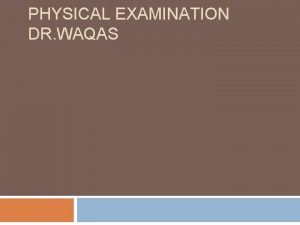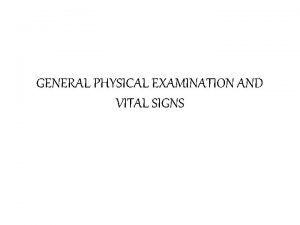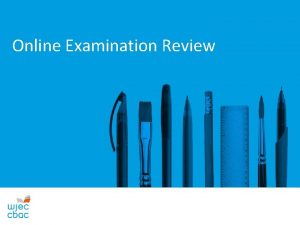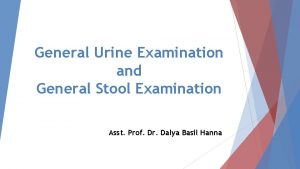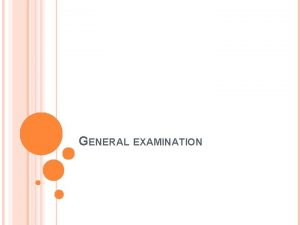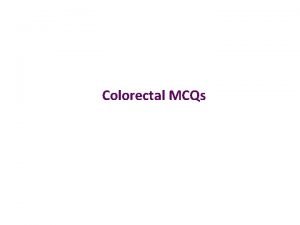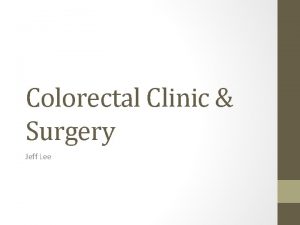General Physical Examination Dr Mahmoud AlAwaysheh General Colorectal






















- Slides: 22

General Physical Examination Dr. Mahmoud Al-Awaysheh General & Colorectal Surgeon Mutah University - Introductory Course 2020

BEING A ‘GOOD’ DOCTOR • From your first day as a student you have professional obligations placed upon you by the public, the law and your colleagues which continue throughout your working life. • Put yourself in the situation of the patient. Consider how you would wish to be cared for in the patient’s situation. • When you are dealing with patients, always consider your: ( ABCD ) • A: attitude – how would I feel in this patient’s situation? • B: behavior – always treat patients with kindness and respect • C: compassion – recognize the human story that accompanies each illness • D: dialogue – listen to and acknowledge the patient

• DRESS AND DEMEANOUR : Your dress style and demeanour should never make your patient or colleagues uncomfortable or distract them. (e. g. : Exposing your chest is not acceptable ) • Wear white coats for reasons of professionalism, identification and as a barrier to infection. these must be clean and you should always wear a name badge which can be read easily. • Whenever you see a patient , introduce yourself clearly. A friendly smile helps to put your patient at ease. • COMMUNICATION SKILLS : Excellent communication skills allow you to identify a patient’s problem rapidly and accurately and improve patient satisfaction • RESPECT : The best doctors are humble. • HAND WASHING AND CLEANLINESS : Transmission of microorganisms from the hands of healthcare workers is the main source of cross-infection.

Beginning the Examination : THE SETTING FOR A PHYSICAL EXAMINATION • As you greet the patient, identify yourself and know your patient’s name. Appear calm and organized even when you feel inexperienced. It is common to forget part of the examination, especially at first. • CONSENT : As a student and as a doctor or nurse Always obtain consent / Seek permission before undertaking any examination or investigation • Always offer a chaperone • Make the Patient Comfortable : Patient Privacy and Comfort : Close nearby doors, draw the curtains in the hospital or examining room, and wash your hands carefully before the examination begins.

Cardinal Techniques of Examination • The sequence of examination is: (IPPA) • Inspection ( LOOK ) : Close observation of the details of the patient’s appearance, behavior, and movement. • Palpation ( FEEL ) : Tactile pressure from the palmar fingers or finger pads to assess areas • Percussion : is a method of TAPPING on a surface to determine the underlying structure. It is done with the middle finger of one hand to deliver a rapid tap or blow with a relaxed wrist motion, against the middle finger of the other hand laid against the surface of the chest or abdomen, to evoke a sound wave such as resonance or dullness from the underlying tissue or organs.

• Auscultation : is LISTENING to the internal sounds of the body, usually using a stethoscope. Use the diaphragm and bell of the stethoscope to detect the characteristics of heart, lung, and bowel sounds. • Examining from the Patient’s Right Side. books recommend examining the patient from the patient’s right side, moving to the opposite side or foot of the bed or examining table as necessary. This is the standard position for the physical examination and has several advantages compared with the left side.

FIRST IMPRESSIONS • The physical examination starts as soon as you see the patient. • 1) Gait and posture : Observe the patient as he walks.

• 2) The handshake : This may provide diagnostic clues • 3) Facial expression and general demeanor/behavior • Ask yourself: • ‘Does this patient look well? ’ Facial expression reflect physical and psychological well-being

• 4) Clothing : Clothing gives clues about personality, state of mind and social circumstances. How is the patient dressed? Is the clothing suitable for the temperature and weather? Is it clean and appropriate to the setting? • Young people wearing dirty clothes may have problems with alcohol or drug addiction. • Elderly patients with fecal or urinary soiling may be unable to look after themselves because of physical disease, immobility, dementia or other mental illness. • Patients wearing baggy clothes to cover weight loss.

• 5) Complexion (the natural color and appearance of a person's skin, especially of the face. ) Facial color depends on oxyhemoglobin, hemoglobin concentration and abnormal pigments • A pale complexion may be misleading but can suggest anemia (reduced hemoglobin ). The pallor of anemia is best seen in the mucous membranes of the conjunctivae, lips and tongue. • Facial plethora ( an excess of blood causing a red complexion ) is caused by raised hemoglobin concentration

• Cyanosis is a blue discoloration occurs when the concentration of deoxygenated hemoglobin is increased. • Central cyanosis : This is seen at the lips and tongue. • Peripheral cyanosis : This occurs in the hands or feet. • Jaundice is a yellow discoloration of the skin, mucous membranes, and the whites of the eyes (the sclera) caused by increased amounts of bilirubin in the blood.

• 6) Odors (of the body or breath) : • Tobacco’s smell • The smell of alcohol on a patient’s breath • Fetor ( a foul or unpleasant odor ) hepaticus : is a condition in which the breath of the patient is musty, and occasionally fecal in nature (‘mousy’ smell ). Seen in patients with liver failure. • ketones: a sweet/fruity smell (like nail varnish remover) due to acetone in diabetic ketoacidosis. • Uremic fetor : is a urine-like odor or fishy smell of persons with uremia. Seen in patients with chronic kidney disease.

• 7) Spot diagnoses : Many disorders have characteristic facial features , that you should easily recognize on first contact with the patient. e. g. : Systemic sclerosis , chromosomal abnormalities (Down’s syndrome (trisomy 21 – 47 XX/XY + 21) , Turner’s syndrome (45 XO))

• Common patterns of HAIR DISEASE : • Hair loss, also known as alopecia or baldness can be total or partial. • Excess hair growth. • THE TONGUE : • Examination sequence • ■ Ask the patient to put out his tongue. • ■ Look at the size, shape, movements, colour and surface • Abnormal findings • Macroglossia (enlargement of the tongue) • Fasciculation (irregular twitching of the tongue) • White patches ( Leukoplakia ) • Glossitis is a smooth reddened tongue

THE HANDS • Examination sequence • ■ Inspect the dorsal and then palmar aspects of both hands. • ■ Note changes in the: • ■ skin • ■ nails • ■ soft tissues (evidence of muscle wasting) • ■ joints. • ■ Feel the temperature.

• Deformity : e. g. : in longstanding rheumatoid arthritis , Marfan’s syndrome Trauma is the most common cause of hand deformity. • Color : cyanosis in the nail bed tobacco staining of the fingers • Temperature : warm vs cold.

• Skin : Callosities (a thickened and hardened part of the skin) : Manual work Look at the flexor surfaces of the wrists and forearms : venipuncture marks of intravenous drug use and linear (usually transverse), multiple wounds or scars from deliberate self-harm • Muscles Small muscle wasting of the hands , producing ‘dorsal guttering’ of the hands

• Fingernails : ( Nail abnormalities ) • Nail changes are useful in diagnosing diseases

• Finger clubbing is painless soft-tissue swelling of the terminal phalanges. The enlargement increases convexity of the nail with loss of the normal angle between the nail and the proximal nail fold. The angle increases to 180° or more, and the nail bed feels spongy. Schamroth’s window sign is absent ( Place the nails of corresponding fingers back to back and look for a visible gap between the nail beds ) • .

• WEIGHT AND HEIGHT : • Weight is an important indicator of general health and nutrition • Serial height is helpful in monitoring growth in children and in the elderly. • Record the body mass index (BMI), BMI is calculated from the formula: weight/height 2 (using metric units, kg/m 2). For example, 60 kilograms ÷ (1. 65 meters x 1. 65 meters) = 22. 03.

• HYDRATION : In adults 60– 65% of body mass is water. • Dehydration : fluid loss, e. g. vomiting, diarrhea, sweating, burns and polyuria (excessive passage of urine (greater than 3 L over 24 hours in adults)). • Edema : is tissue swelling. edema can be generalized, localized.

 Colorectal cancer drug trial
Colorectal cancer drug trial Ann lyons colorectal surgeon
Ann lyons colorectal surgeon Colorectal cancer
Colorectal cancer Colorectal
Colorectal Amsterdam criteria
Amsterdam criteria General physical exam
General physical exam Positioning and draping for physical examinations
Positioning and draping for physical examinations General appearance in physical examination
General appearance in physical examination Mahmoud abdelfattah age
Mahmoud abdelfattah age Passport poem summary
Passport poem summary Dr mahmoud salman
Dr mahmoud salman Mahmoud arafa
Mahmoud arafa Boudarene mahmoud
Boudarene mahmoud Mahmoud sarmini md
Mahmoud sarmini md Dr mahmoud khattab
Dr mahmoud khattab Mahmoud khattab md
Mahmoud khattab md Hana mahmoud
Hana mahmoud Physical examination tray
Physical examination tray Physical assessment types
Physical assessment types Abbott nutrition focused physical assessment
Abbott nutrition focused physical assessment Percussion abdominal assessment
Percussion abdominal assessment Bates guide to physical examination
Bates guide to physical examination Office-based pre-participation physical examination
Office-based pre-participation physical examination

